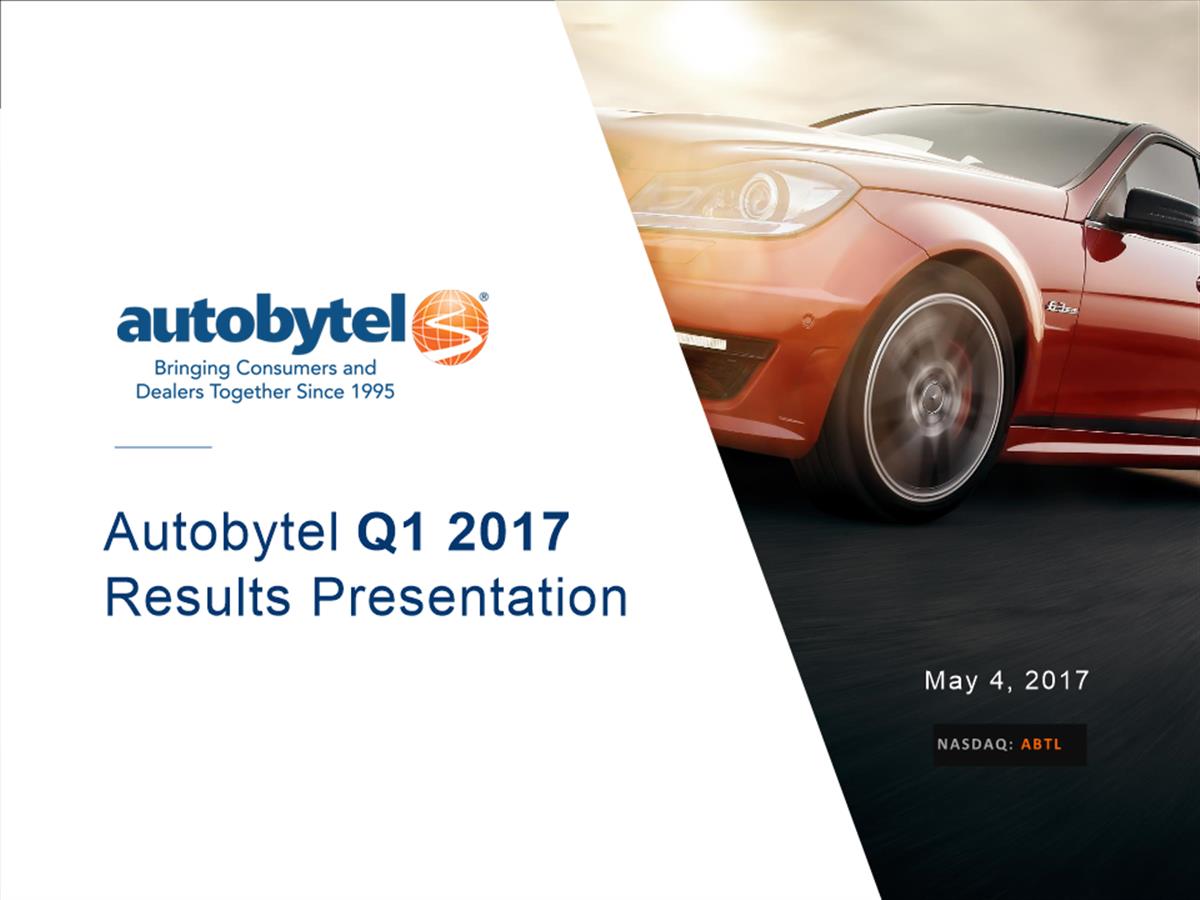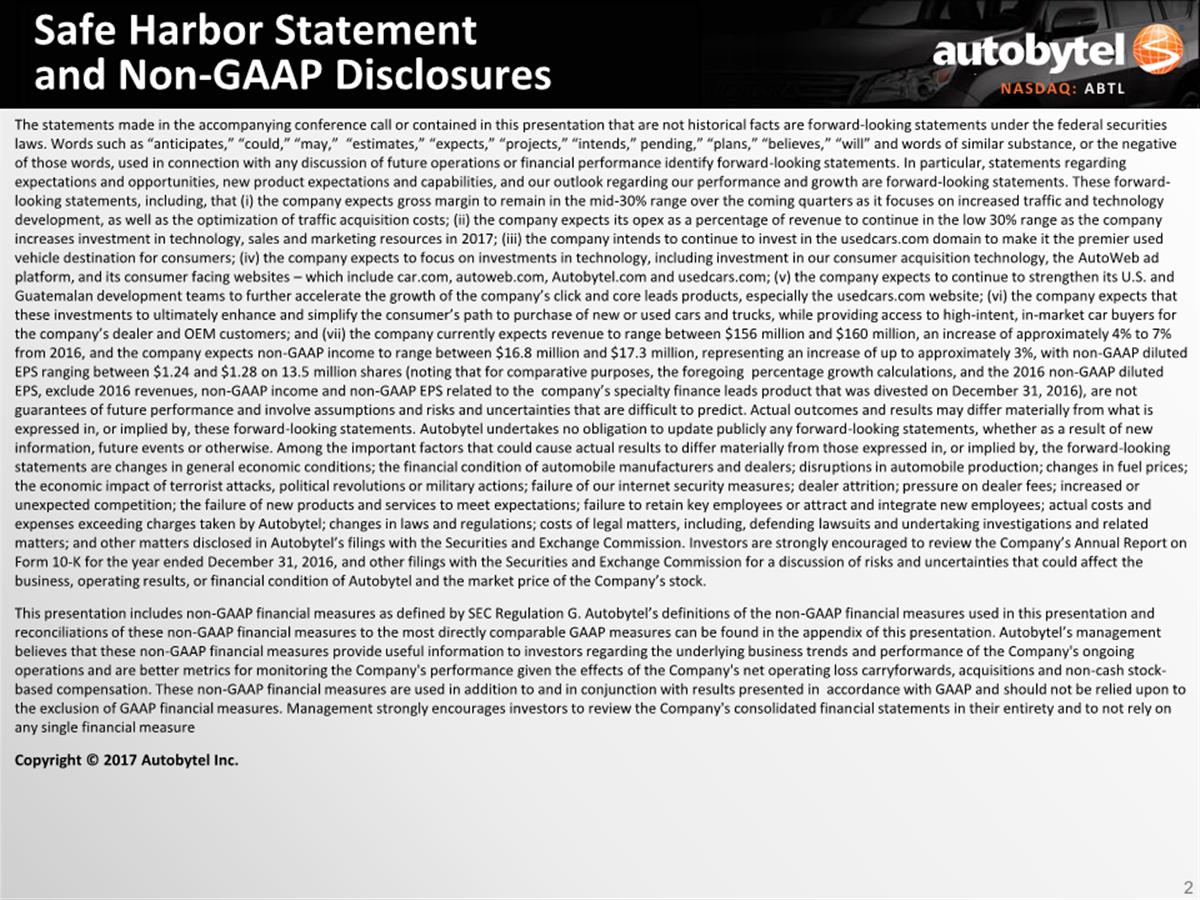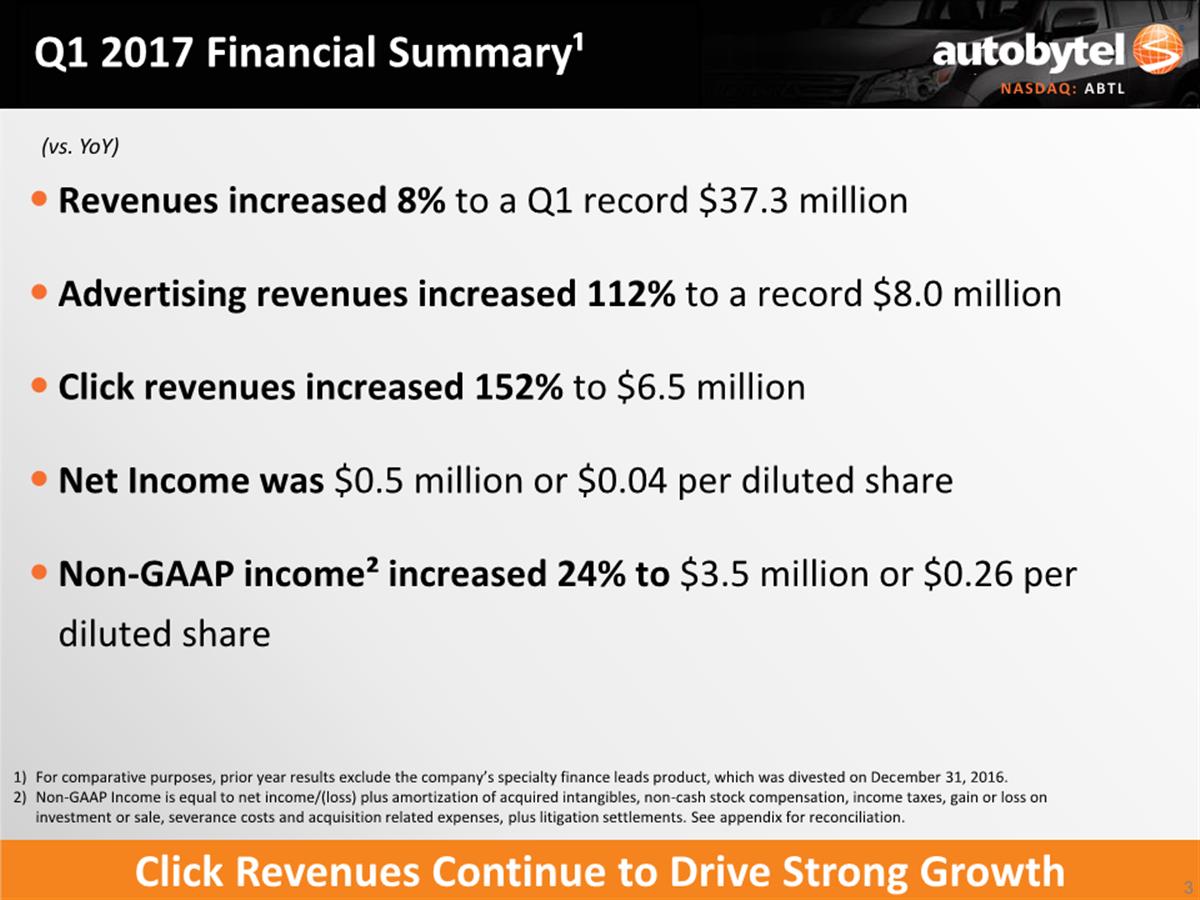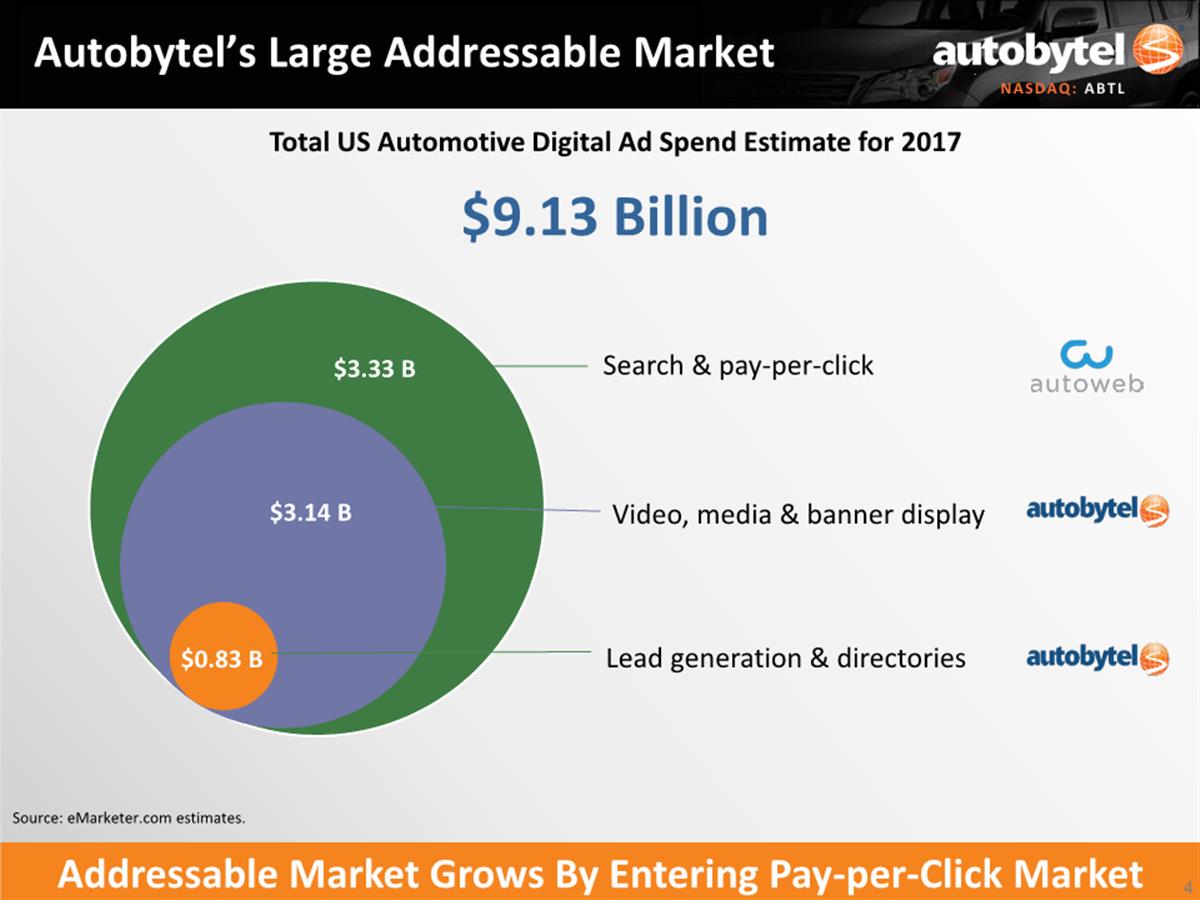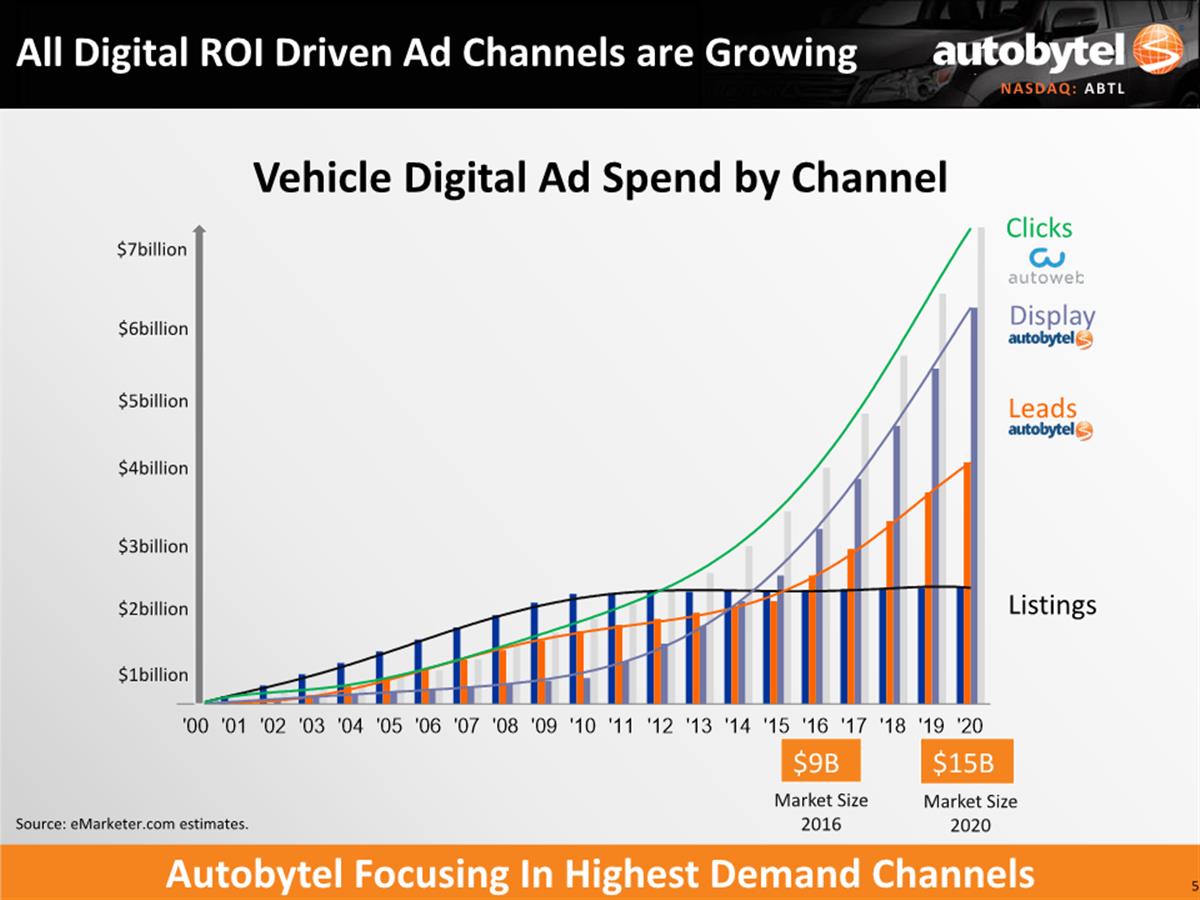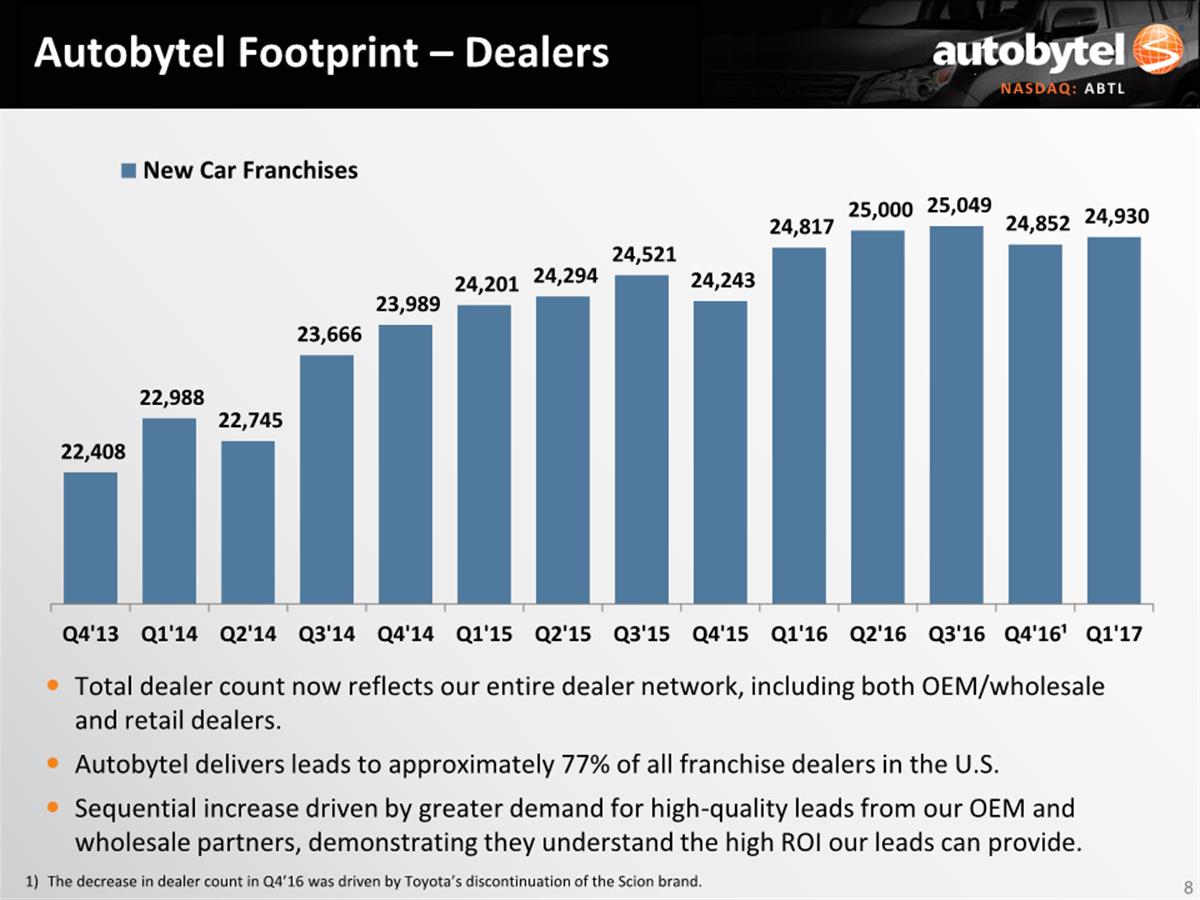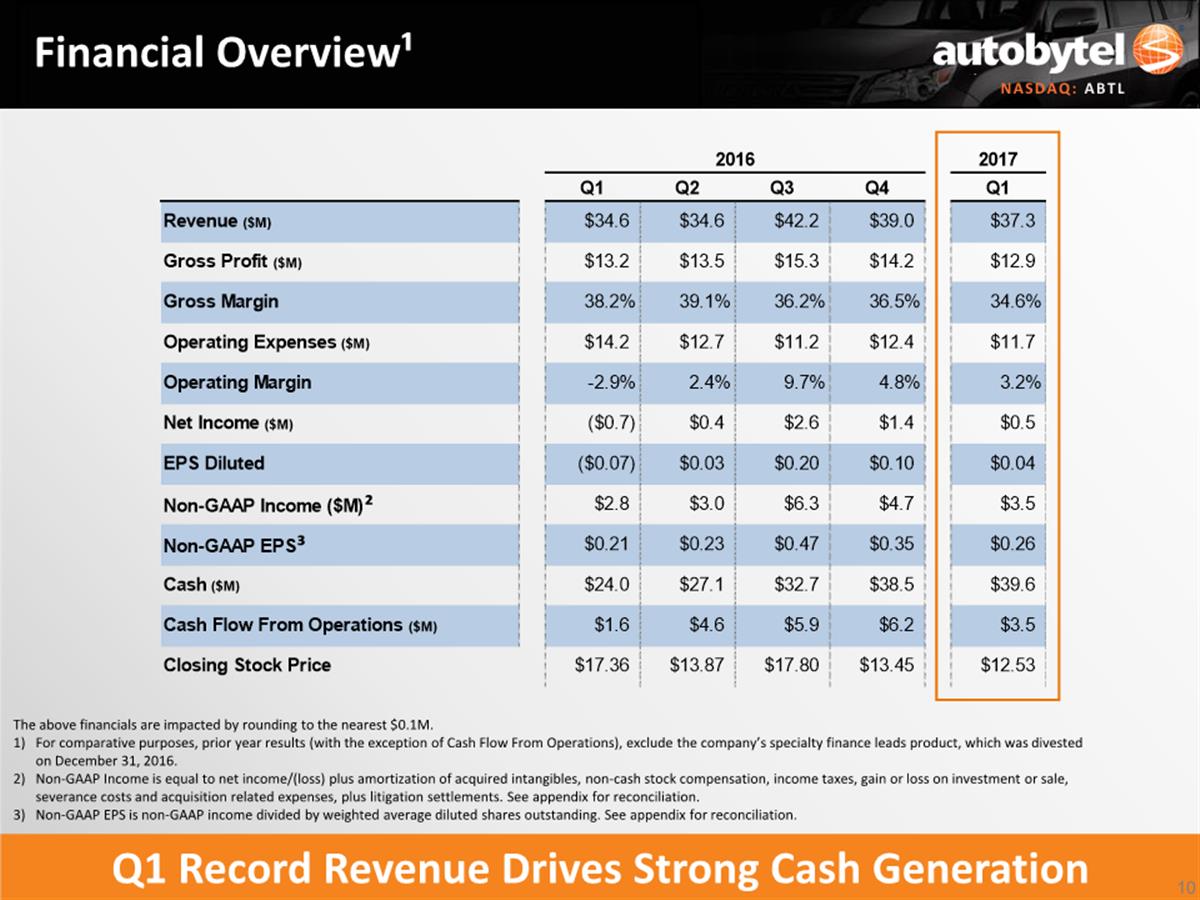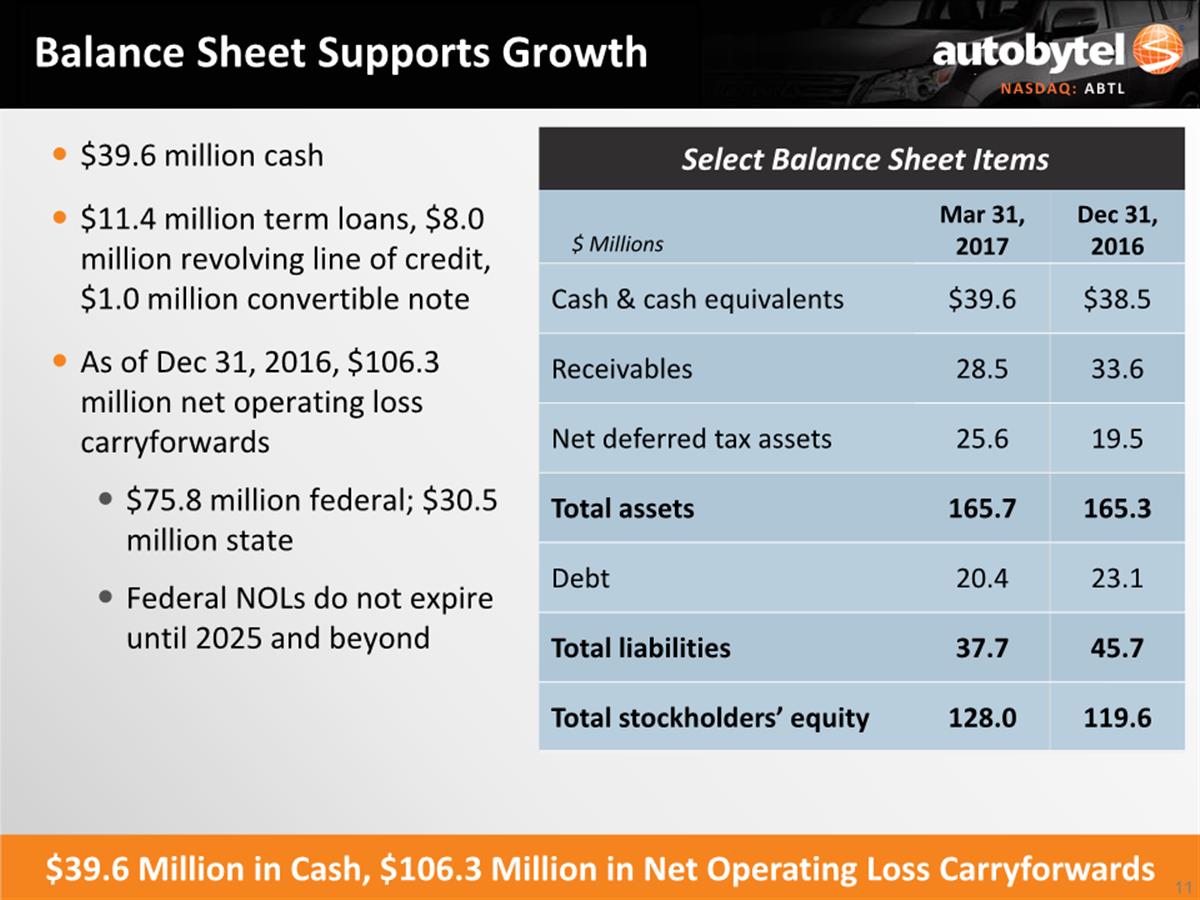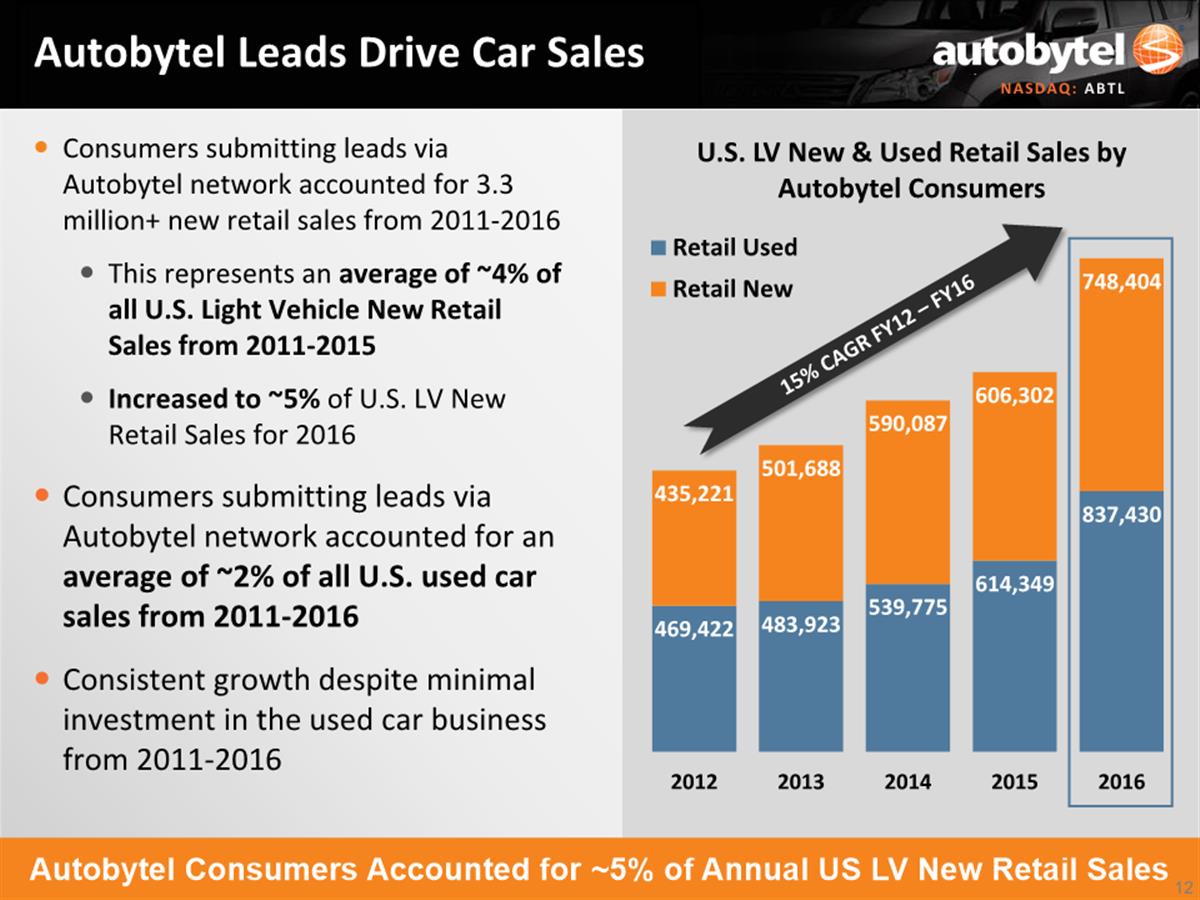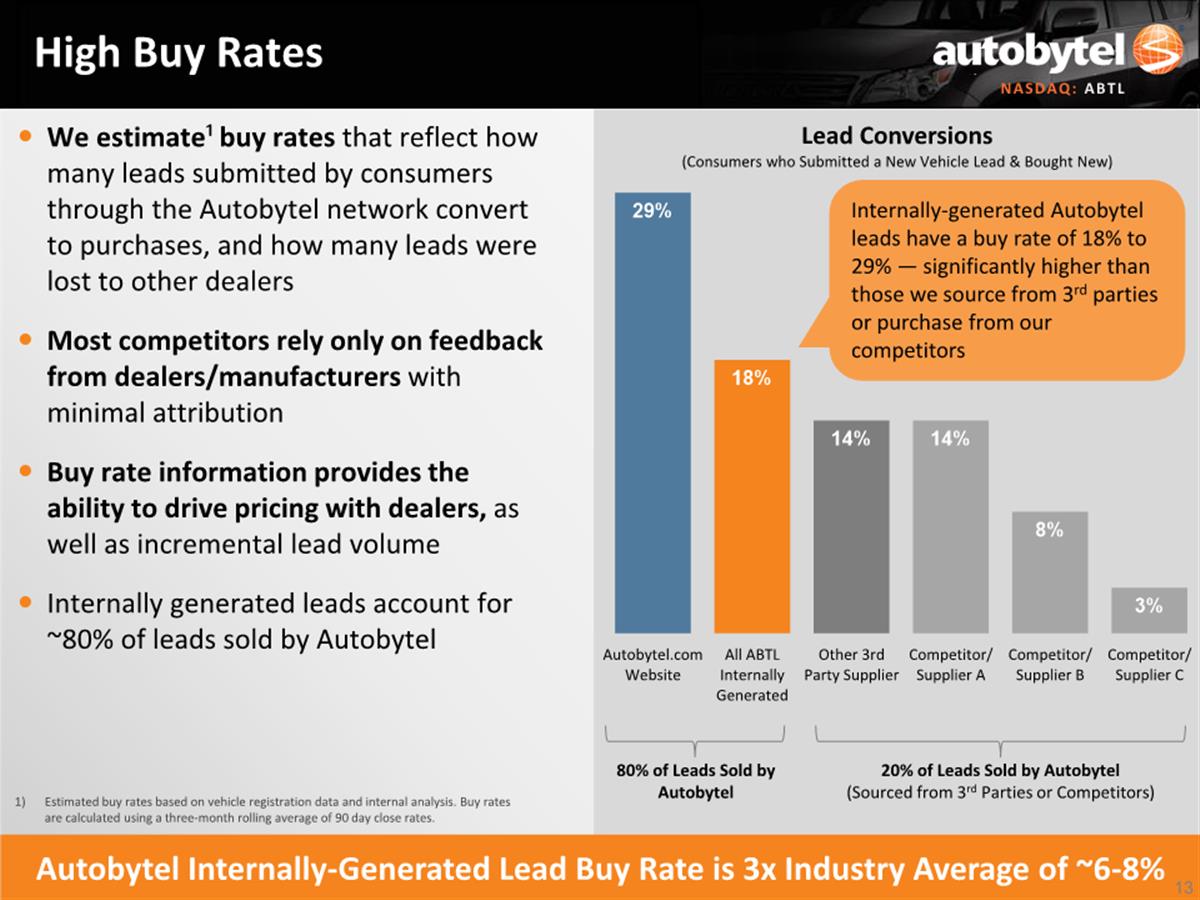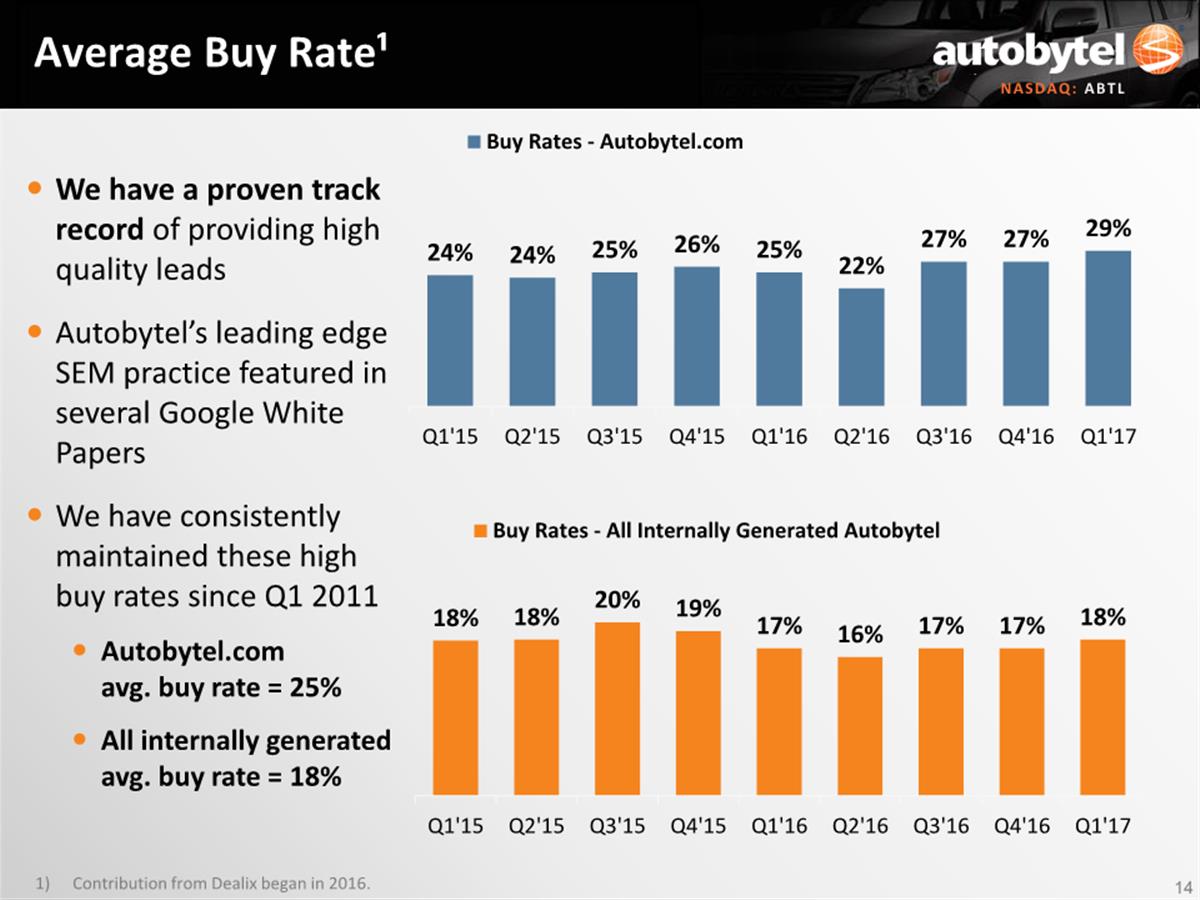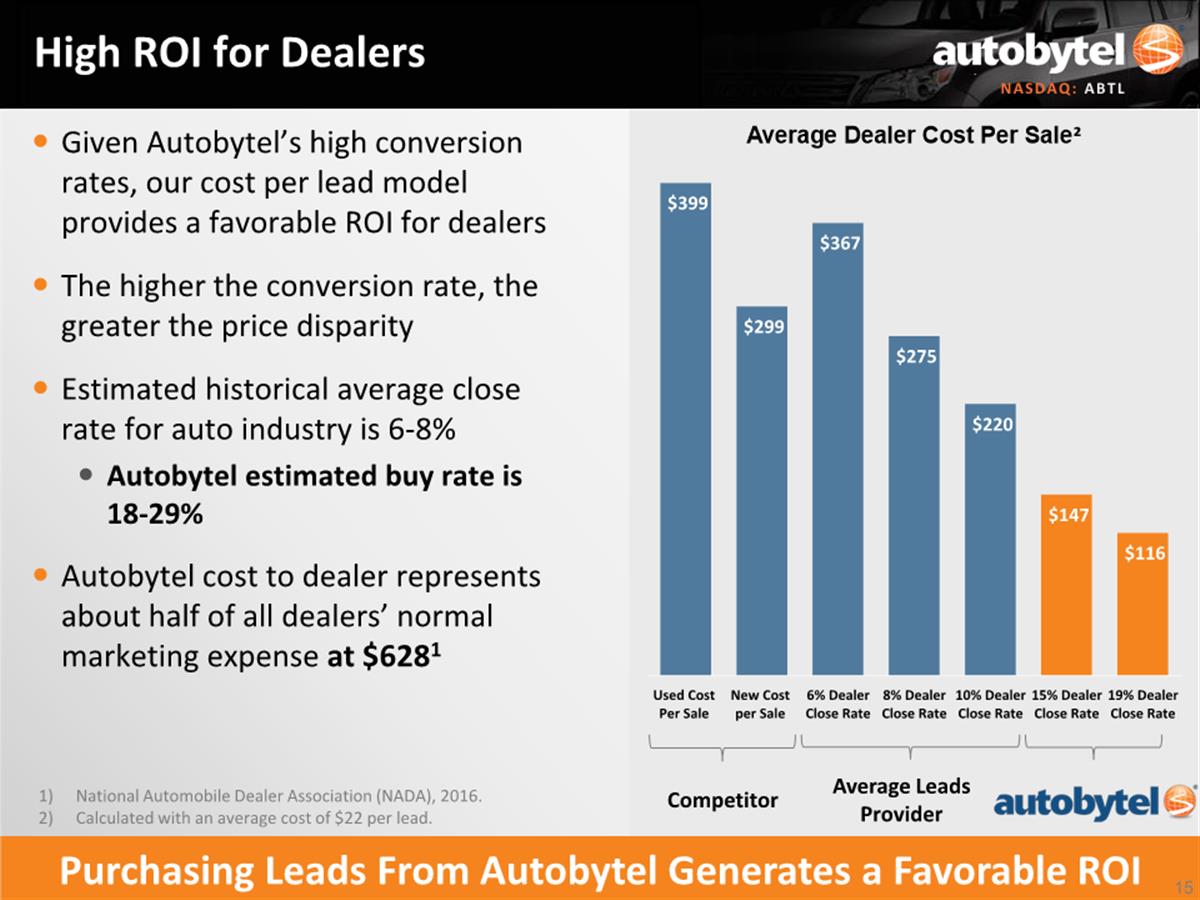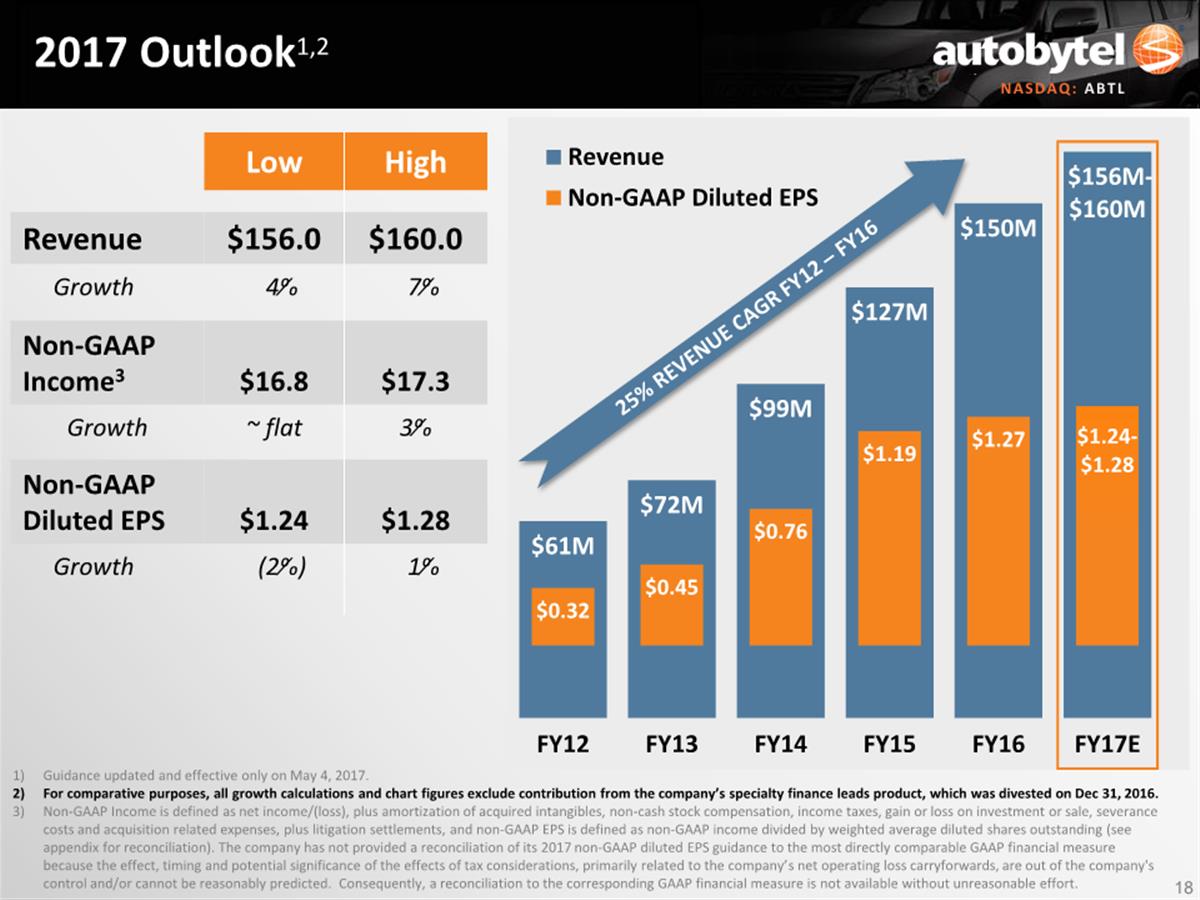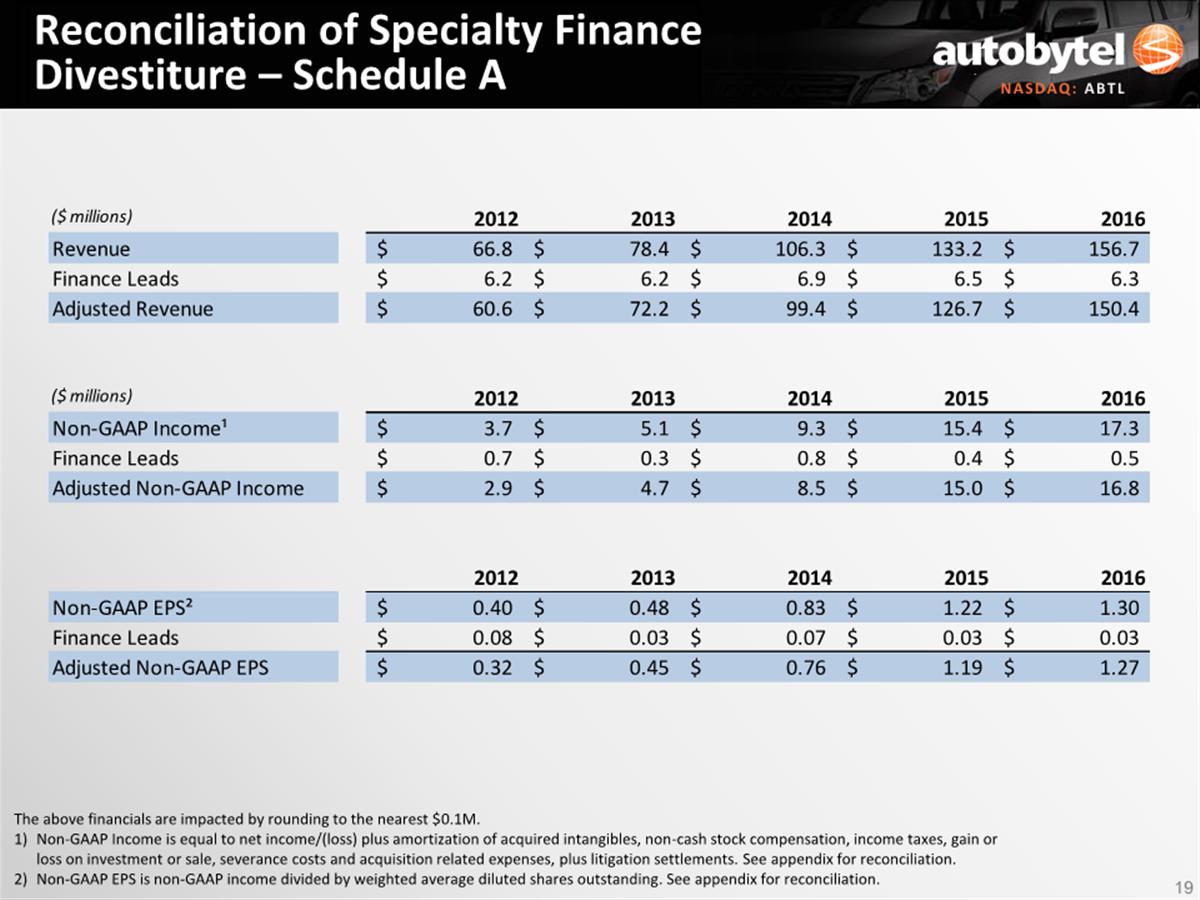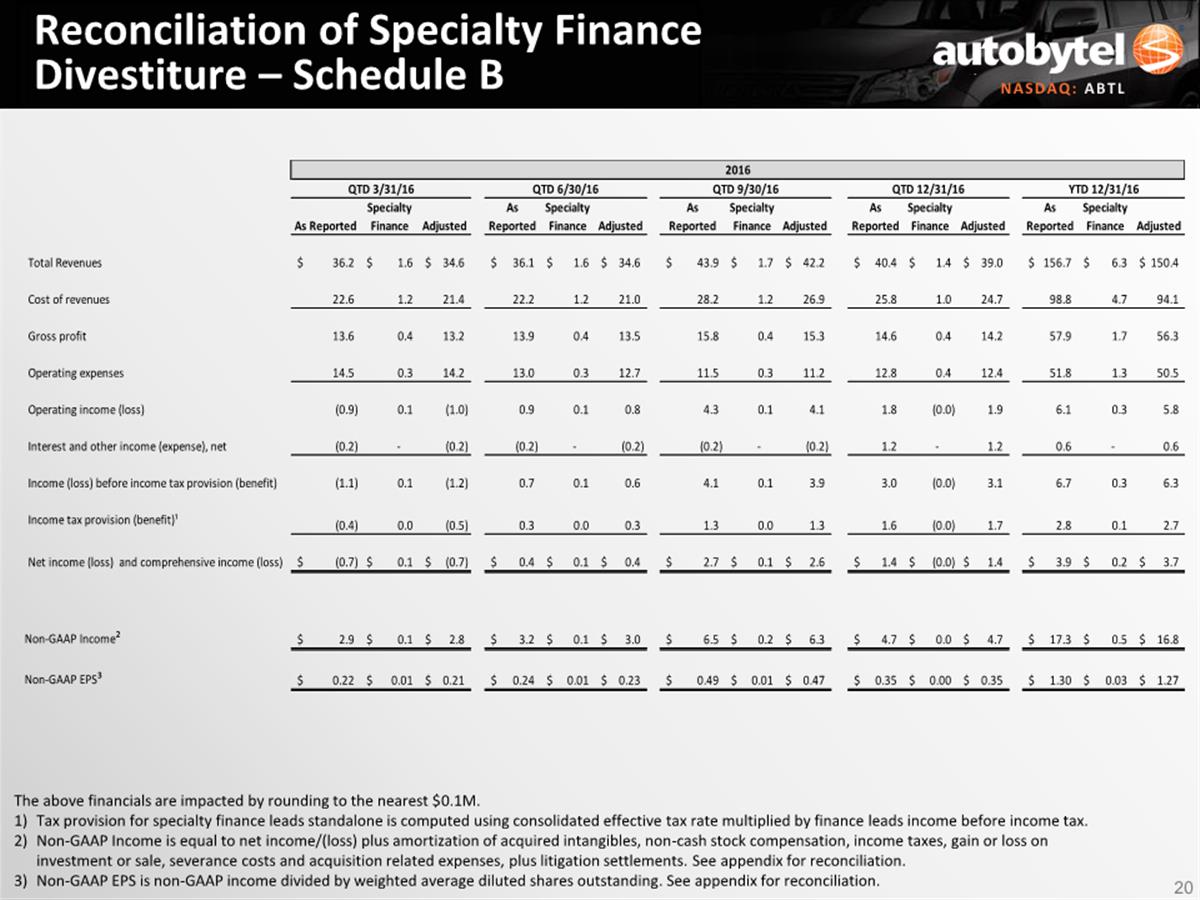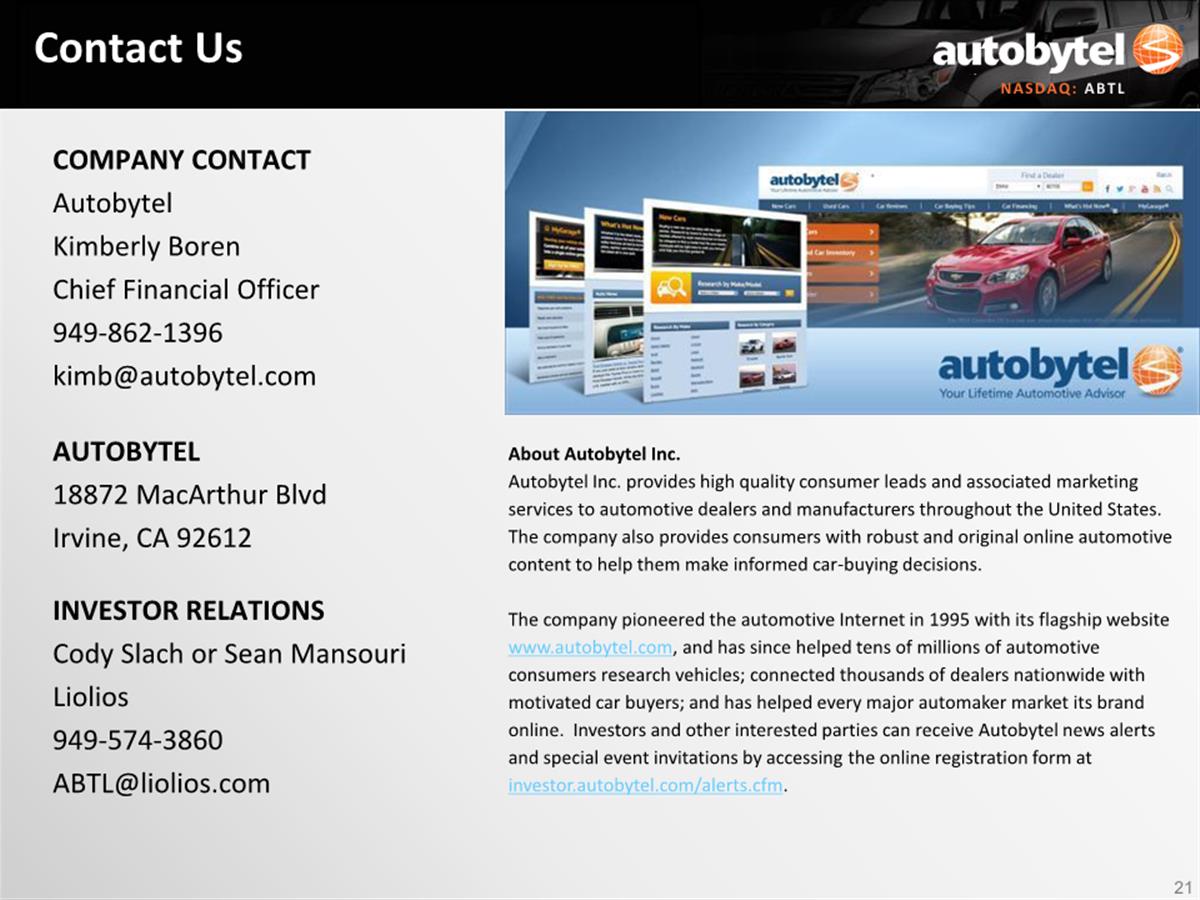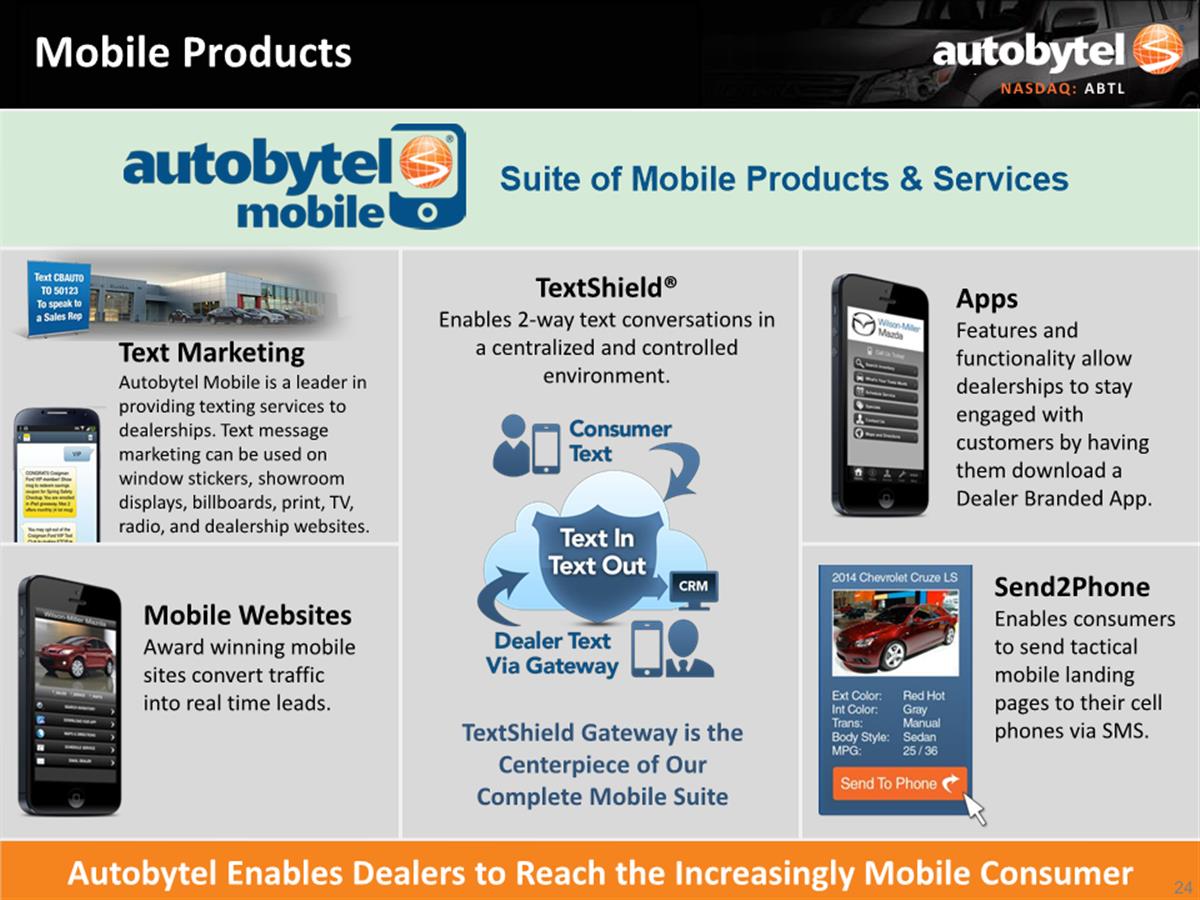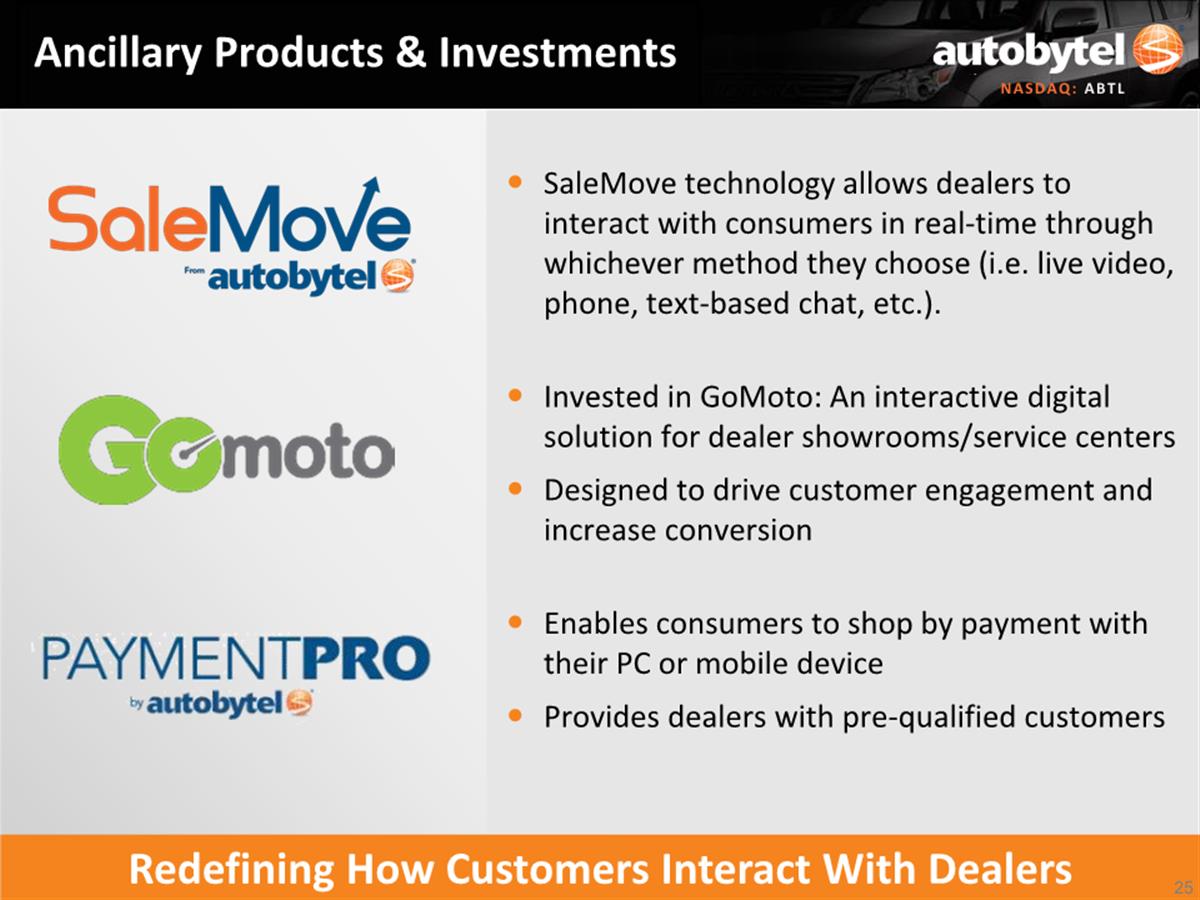Attached files
| file | filename |
|---|---|
| EX-99.1 - PRESS RELEASE - AutoWeb, Inc. | ex99-1.htm |
| 8-K - FORM 8-K - AutoWeb, Inc. | abtl8k_may42017.htm |
Exhibit
99.2
AUTOBYTEL INC.
Moderator: Sean Mansouri
May 4, 2017
5:00 p.m. ET
Operator:
This is conference
# 9332168.
Good
afternoon, everyone. Thank you for participating in today's
conference call to discuss Autobytel financial results for the
first quarter ended March 31, 2017.
Joining
us today are Autobytel's President and CEO, Jeff Coats; the
company's CFO, Kimberly Boren; and the company's outside Investor
Relations Advisor, Sean Mansouri, with Liolios Group.
Following their
remarks, we will open the call for your questions. I would now like
to turn the call over to Mr. Mansouri for some introductory
comments.
Sean
Mansouri:
Thank
you.
Before
I introduce Jeff, I remind you that during today's call, including
the question-and-answer session, any projections and
forward-looking statements made regarding future events or
Autobytel's future financial performance are covered by the safe
harbor statements contained in today's press release, the slides
accompanying this presentation and the company's public filings
with the SEC.
Actual
events may differ materially from those forward-looking statements.
Specifically, please refer to the company's Form 10-Q for the
quarter ended March 31, 2017, which was filed prior to this call as
well as other filings made by Autobytel with the SEC from time to
time. These filings identify factors that could cause results to
differ materially from those forward-looking
statements.
There
are slides included with today's presentation to help illustrate
some of the points being made and discussed during the call. The
slides can be accessed by visiting Autobytel's website at
autobytel.com. When there, go to Investor Relations and then click
on “Events and Presentations.”
Please
also note that during this call and/or in the accompanying slides,
management will be disclosing non-GAAP income and non-GAAP EPS. For
purposes of the 2017 guidance, we'll be adjusting 2016 revenues,
non-GAAP income and non-GAAP EPS to reflect the exclusion of the
company's specialty finance leads product that was divested at
December 31, 2016.
And for
year-over-year comparisons, prior year results with the exception
of cash flow from operations for all periods presented are adjusted
to exclude the company's specialty finance leads product, which was
divested on December 31, 2016. These are non-GAAP financial
measures as defined by SEC Regulation G.
Reconciliations of
these non-GAAP financial measures to the most directly comparable
GAAP measures are included in today's press release and/or in the
slides, which are posted on the company's website.
And
with that, I'll turn the call over to Jeff.
Jeffrey
Coats:
Thank you, Sean,
and good afternoon, everyone. Thank you for joining us today to
discuss our first quarter 2017 results. As a reminder to those of
you who are new to Autobytel, we are a pioneer and leading provider
of online digital automotive services, connecting in-market car
buyers with our dealer and manufacturer customers.
We are
happy to announce that the momentum we gained from our record 2016
has carried into the first quarter of 2017. Our results were
highlighted by another quarter of triple-digit growth in our clicks
business, which is becoming a meaningful contributor to our overall
financial performance and continues to strengthen our position as a
digital leader in the automotive industry.
In line
with expectations, lead revenues for the quarter were down slightly
due to the effects of last year's initiative to systematically
reduce lower quality leads supply. It's worth noting that this
quality initiative continues to drive increased retention across
our customer base, while providing us with more control of our
high-quality leads supply as we begin to rely less and less on
third-party suppliers.
But
before commenting further, I'd like to turn the call over to Kim
and have her take us through the important details of our financial
results. Kim?
Kimberly
Boren:
Thanks, Jeff, and
good afternoon, everyone. As noted in our press release today, for
year-over-year comparative purposes, the results for all periods
presented and discussed on our call today exclude our specialty
finance leads product, which was divested on December 31,
2016.
For
those of you following along with our earnings presentation, on
Slide 6, you see our first quarter revenues increase 8 percent to
$37.3 million compared to an adjusted $34.6 million in the year-ago
quarter. This was primarily driven by continued strong growth in
advertising click revenues, which increased 152 percent to $6.5
million.
For
listeners who have been following our story, you may recall that
we’ve historically broken out our leads business to
distinguish between our wholesale channel, which derives revenue
through automotive manufacturers for dealers participating in their
corporate leads program, and our retail channel, which comes
directly from automotive dealers.
Due to
evolving marketplace dynamics in the leads business, such as last
year's transition of 190 retail dealers into one comprehensive OEM
program as well as feedback from our shareholders and covering
analysts, we've elected to simplify our story and aggregate the two
channels, as it is no longer appropriate to look at these channel
dynamics separately.
With
that said, we will continue to break out new versus used car leads
given that used cars remains a growth story for Autobytel with a
long-term market opportunity. Jeff will expand on our used car
business later in the call.
Moving
to Slide 7, you'll see that we delivered approximately 2.2 million
automotive leads during the first quarter compared to 2.3 million
last year, a slight reduction as we work to replace a meaningful
amount of the eliminated low-quality volume with higher-quality
leads from our internal lead generation.
And on
Slide 8, you'll see that dealer counts stood at 24,930 at March
31st, a
slight increase from Q4. The increase was driven by greater demand
for high-quality leads from our OEM and wholesale
partners.
Similar
to our leads breakout described earlier, these dealer counts
reflect all of the dealers we sell leads to including both the
wholesale and retail channels for new cars.
Moving
on to advertising, our advertising revenues increased 112 percent
to a record $8 million compared to $3.8 million in the year-ago
quarter. The growth was once again due to a significant increase in
click revenues.
On
Slide 9, you'll see click revenues increase 152 percent to $6.5
million compared to $2.6 million in the same period last year. The
increase was driven by the continued strong growth of impressions,
click-through rates, and effective CPMs.
Now
moving to Slide 10, gross profit during the first quarter was $12.9
million compared to an adjusted $13.2 million in the year-ago
quarter. In line with expectations, gross margin was 34.6 percent.
We continue to expect gross margins to remain in the mid-30 percent
range over the coming quarters as we focus on increasing traffic
and investing in technology.
Total
operating expenses in the first quarter decreased 18 percent to
$11.7 million compared to an adjusted $14.2 million in the year-ago
quarter. The decrease was driven by nonrecurring expenses in the
year-ago quarter including $1.3 million of severance expense, as
well as business optimization initiatives, and lower headcount in
the 2017 quarter. As a percentage of revenues, total operating
expenses were 31.3 percent compared to an adjusted 41.1 percent for
the year-ago quarter [Speaker
inadvertently stated 41.4 percent instead of 41.1 percent as
reflected in the accompanying Press Release].
We
expect our OpEx as a percent of revenue to continue in the low 30
percent range as we increase investments in technology, and sales
and marketing resources in 2017.
On a
GAAP basis, net income for the first quarter was $484,000 or $0.04
per diluted share on 13.3 million shares, compared to an adjusted
net loss of $749,000 or negative $(0.07) per share on 10.5 million
shares in the year-ago quarter. The increase was driven by the
aforementioned growth of advertising click revenues and reduced
operating expenses.
For the
first quarter, non-GAAP income, which adds back amortization on
acquired intangibles, noncash stock-based compensation, acquisition
costs, severance costs, gain or loss on investment or sale,
litigation settlements, and income taxes, increased 24 percent to
$3.5 million or $0.26 per diluted share, compared to an adjusted
$2.8 million or $0.21 per diluted share in the first quarter of
2016.
Cash
provided by operations in the first quarter improved to $3.5
million, compared to an unadjusted $1.6 million in the prior year
quarter.
On
Slide 11, you'll see that our cash balance remains strong and
continues to grow despite debt pay down, with cash and cash
equivalents of $39.6 million at March 31, 2017, compared to $38.5
million at December 31, 2016. Total debt at March 31, 2017 was
reduced to $20.4 million compared to $23.1 million at the end of
2016.
With
that, I'll now turn the call back over to Jeff.
Jeffrey
Coats:
Thank you, Kim. As
I mentioned earlier, the first quarter of 2017 was highlighted by
the strong momentum in our clicks business. We are continuing to
increase click volumes with existing clients and have begun to add
OEMs, large dealer groups, dealer agencies and Tier-2 dealer
associations.
In
fact, one major Asian OEM has recently committed to a low 7-figure
marketing spend agreement in 2017 that would send our high-intent
traffic to their Tier-1 consumer websites. As I've mentioned in the
past, our strong growth in clicks up to this point has only come
from a small number of dealer and OEM customers with approximately
98 percent retention. Customer feedback remains very
positive.
In Q3
2016, we began heavily investing in traffic acquisition to
accelerate the continued growth of both of our high-quality clicks
product and our high-quality leads supply. OEMs typically have very
advanced digital marketing capabilities, and their increased demand
continues to demonstrate that they understand the high ROI from our
high-quality leads and clicks.
We have
actually been approached by several OEMs about restructuring our
relationships to transition all of their retail dealers on our
network into one comprehensive OEM program for each respective OEM,
similar to the 190 retail dealer transitions we had with a
different OEM last year. These discussions further reflect the
evolving dynamics in our leads business and were the contributing
factor in our decision to combine retail and wholesale leads in our
tracked metrics.
We’ve found
that these restructured agreements have several benefits to our
business. In addition to the customer service and administrative
relief of dealing with one OEM as opposed to hundreds of dealers,
the agreement provides us with the opportunity to supply leads to
even more dealers from the OEM that weren't previously on our
network.
Also,
this type of comprehensive relationship allows us to work closer
with the OEM field sales force on best practices and provides us
with a natural channel to introduce new products and
services.
Ultimately, the
benefit of this type of OEM program outweighs the loss of the
direct dealer relationships. For instance, the results of last
year's OEM program transition have already been very impressive
with lead volumes up 20 percent versus the same period in
2016.
At the
end of the third quarter last year, we launched a new version of
usedcars.com with fully responsive technology and mobile friendly
application. We remain very excited about the strength of the
“usedcars” domain and will continue to invest in it to
make it the premier used vehicle destination for consumers. Our
investments in the used car business have been paying off with our
traffic to the usedcars.com site increasing more than 25 percent
since the relaunch.
In
addition, our consumer acquisition team has begun launching SEM
campaigns to generate used car leads. This marks our first major
push into used car paid search and is built upon the usedcars.com
website infrastructure. This platform takes advantage of
proprietary techniques and technology acquired from Dealix and
Autotegrity combined with our existing expertise. In just a short
period of time, these SEM campaigns have contributed 17 percent of
our total used car volume.
The
opportunity in the used car business will continue to be
significant. The used car market in the United States has
historically been 2 to 3x that of new, and growth in this market is
projected to outpace new cars for at least the next few years. That
said, our used car business remains a focal point for growth, and
we continue to increase the level of resources dedicated to ramping
our used car platforms for internal lead generation.
Turning
now to our usual industry metrics for the quarter, on Slide 12, you
can see that we estimate sales to consumers submitting new car
leads through Autobytel's network increased 23 percent to
approximately 748,000 units in 2016, which is estimated to have
accounted for approximately 5 percent of all new light vehicle
retail sales in the United States.
From a
used car perspective, we estimate that Autobytel leads accounted
for 837,000 unit sales in 2016, a 36 percent increase over the
prior year and approximately 2 percent of all used car retail sales
in the United States. This compares relatively to flat growth for
the industry at large for both new and used car sales.
On
Slide 13, you'll see that our estimated average buy rate for
internally generated leads in the first quarter was 18 percent,
which remains in our targeted range of 16 percent to 24 percent.
Because of our ongoing commitment to lead quality, we are
continuing to focus on enhanced methodologies to meaningfully
increase the mix of internally generated leads from the current 80
percent level, while only utilizing volume from a small number of
trusted suppliers who share our commitment to quality. As I
mentioned earlier, this has resulted in increased retention across
our customer base.
On
Slide 14, you'll also note that these estimated buy rates have
remained consistently strong since Q1 2011 with Autobytel.com
generating an average buy rate of 25 percent and all Autobytel
internally generated leads at about 18 percent.
We are
often asked how we compare to other pay-per-sale models in the
marketplace. On Slide 15, you can see that at a conservative 15
percent to 19 percent buy rate for leads that we delivered to our
dealer customers, the hypothetical pay-per-sale in our model would
effectively range between $116 and $147 per car sold. This cost
would of course be even lower with our targeted 16 percent to 24
percent buy rates.
Moving
on to the industry outlook, as you can see on Slide 16, Automotive
News has a seasonally adjusted annual run rate or SAAR for total
sales at 17.5 million units for April 2017, which is flat compared
to one year ago and up from 16.6 million units in
March.
And on
Slide 17, you'll see that in April, J.D. Power / LMC automotive
forecasted full year 2017 total light vehicle sales of 17.5 million
units and retail light vehicle sales at 14.2 million units, both
roughly flat from 2016.
Moving
now to our 2017 business outlook highlighted on Slide 18, we
continue to expect revenue to range between $156 million and $160
million, representing an increase of approximately 4 percent to 7
percent from 2016 [Speaker
inadvertently stated 4 to 6 percent but actual range was 4 to 7
percent as reflected in the accompanying Press Release and
Slides]. We also expect non-GAAP income to range between
$16.8 million and $17.3 million, representing an increase of up to
approximately 3 percent for 2016 with non-GAAP diluted EPS ranging
between $1.24 and $1.28 on 13.5 million shares.
Note
that for comparative purposes, the foregoing percentage growth
calculations and 2016 non-GAAP diluted EPS exclude 2016 revenues,
non-GAAP income, and non-GAAP EPS related to the company's
specialty finance leads product that we divested on December 31,
2016.
2017
remains a year of growth and continued investment for Autobytel. We
will focus on investments in technology, including investment in
our consumer acquisition technology, the AutoWeb ad platform, and
our consumer-facing websites, which include Car.com, AutoWeb.com,
Autobytel.com and usedcars.com. We are also investing in an
enterprise data platform, which will combine all of our data into
one unified data
lake.
This
will enable us to continue to optimize the consumer experience,
increase efficiency of operations, and provide a more personalized
experience for our customers. We also expect to continue to
strengthen our U.S. and Guatemalan development teams to further
accelerate the growth of our click and core leads products,
especially the usedcars.com website. And, we expect these
investments to ultimately enhance and simplify the consumer's path
to purchase of new or used cars and trucks while providing access
to high-intent, in-market car buyers for our dealer, and OEM
customers.
At this
time, Operator, we’re happy to take questions.
Questions and
Answers
Operator:
Thank you, sir.
Ladies and gentlemen, at this time, if you have a question, please
press star, then one on your touchtone telephone. If your question
has been answered, or you wish to remove yourself from the queue,
please press the pound key.
Our
first question will come from Sameet Sinha with B. Riley. Please
proceed.
Sameet
Sinha:
A couple of
questions here. So talking about the used car business, you said 78
percent of your volume is coming through search engine marketing.
Where is the balance of the volume coming from?
And the
second question is, if we look at your revenue, the way you
maintained full year guidance despite having a very strong Q1. If
you assume a 5 percent sequential growth in revenue in the second
quarter, which is to be expected because of a seasonally strong
quarter, you're basically saying the second half, you're expecting
flat year-over-year revenue –adjusted revenue. Can you talk
about that? Then, I have a follow-up.
Jeffrey
Coats:
Sameet, I'll answer
your first question, and Kim can answer the second one. We (gain)
our used car lead volume through partnerships with other firms that
we buy the leads from, which is a large portion of our used car
volume as well as the pure organic leads that come off of our
website, in addition to what we're doing from an SEM
standpoint.
But we
are continuing to invest additional resources in our SEM
capabilities in order to drive a higher volume of that traffic
–of that volume. And of course, it just takes a little bit of
time because we are trying to make sure that we're generating the
same kind of quality. So overall, about 50 percent of our used
leads are organic in nature, and the remainder are leads that we
buy from partners on the outside.
Kimberly
Boren:
And then, Sameet,
for your second question regarding revenues. So one quick misnomer
in what you said. Q2 is typically lower than Q1. So Q1 and Q3 are
typically our stronger quarters whereas Q2 and Q4 are typically our
weaker quarters, although we've seen that changing a little bit
with the incentives in the markets in Black Friday in the fourth
quarter.
And
with automotive projections, we'd expect this year to be a little
bit choppy. But in any case, Q2 should be lower than Q1 from a
seasonal perspective. And then I also wonder if you're excluding
the specialty finance numbers when you said that there would be
little growth quarter –or year-over-year from a quarterly
perspective in the second half.
Sameet
Sinha:
Okay. It was, I
guess, the second quarter seasonality which I had not understood
properly. My follow-up question is, can you talk about the dealer
count? SAAR finally started to move up. What are the trends that
you think that's a sustainable trend at this point or is this
something that happened one time? Can you elaborate on that
please?
Jeffrey
Coats:
I don't think it's
a one-time thing, Sameet. It's really a function of the dealers
that are on our retail program and the dealers that are members of
the corporate leads programs of each of the 31 manufacturers or 31
brands that we do business with. So they have dealers coming in and
out of the corporate programs as they fill the volume that each of
those respective dealers want to buy from the program.
So
those numbers fluctuate. We experience something similar, as you
know, on the retail side, the churn in the dealer body. But to some
extent, the characteristics are somewhat same –somewhat the
same. We've come to realize that more dealers move in and out
during the course of the year than we've recognized historically,
and that's because they're using different products throughout
different times of the year.
We
would expect to see a better dealer profile, number of dealers with
whom we do business as we move forward.
Operator:
Our next question
will come from Gary Prestopino with Barrington
Research.
Gary
Prestopino:
A number of
questions here. Jeff, could you tell us what percentage of your
leads and percentage of your revenues were used? Are you giving out
those statistics anymore in the quarter, and how that shifted
year-over-year?
Kimberly
Boren:
Gary, so we didn't
give out revenues, but if you look in the slide presentation, you
can see the distribution between new and used leads.
Gary
Prestopino:
Yes, all right
–but that's kind of –all right, I can work with that.
The other thing is, Jeff, you've mentioned something about –I
didn't quite catch it. Thought process of focusing more on the
corporate lead programs versus dealers, specific dealers? And I
guess what happens there is, like you say, the OEM –the
dealers work with the OEM manufacturer and I guess sign-up for a
program through the OEM? Is that how that works?
Jeffrey
Coats:
Yes.
Gary
Prestopino:
Okay. So your
thought-process is possibly moving more resources to that channel
of distribution versus having the individual dealer touch
points?
Jeffrey
Coats:
Generally, the
answer to that question is we plan to focus on it a little more,
yes, but not really moving more resources to it per se because it's
already very efficiently managed by the people that we have
involved. We may have to beef that up a little bit over time. But
the manufacturers do a lot of the lifting. We get one invoice as
opposed to hundreds of invoices.
The
manufacturer –dealer –individual dealers will scrub out
leads or return leads to us. That's not really something that
happens in the manufacturer programs. There are a lot of benefits.
In addition, in the program that took place last year, part of the
reason we were willing to do it is they committed to work with us
to sell our other products to the dealers as part of their dealer
base either by co-opting it or just having their field salespeople
help with it or whatever.
And so
that has really helped us increase the sale of some of our other
dealer products in addition. So we think there's a lot of benefit
doing it that way. I don't necessarily expect that perhaps even a
majority of our retail business will evolve in that
direction.
But
there are several other manufacturers that we know are interested
in doing this, and so we'll see on a case-by-case basis whether
that makes sense. The one we've done so far does a lot –does
make a lot of sense, and we would expect some similar benefits in
some of the others. So we'll see.
And in
addition, it also positions us much more strongly for our clicks
product to have the manufacturers involve both as a customer of our
clicks product and assisting us with encouraging their dealers to
sign up for it, if not perhaps have some of that co-opted as well.
So there are multiple benefits of this approach.
Gary
Prestopino:
Okay. Just a couple
more questions and I'll jump off. In terms of the AutoWeb business,
I believe you had said that you were just kind of testing that out
with a small subset of dealers, and the plan is to roll it out
throughout 2017. If that's a correct statement, when will all of
this be –the ability, or the AutoWeb product –be rolled
out to all your customer base?
Jeffrey
Coats:
Well, it will take
some time to roll it out to all of the customer base. We've begun
discussions and meetings with various manufacturers and large
dealer groups. As I mentioned in the script, we've already signed
the deal with one particular Asian manufacturer that's committed to
a 7-figure spend on the clicks product for 2017.
Part of
the timing on some of these, particularly with the clicks products,
is we have to do some integration work with either the manufacturer
or the dealer, dealer agency involved in doing it. So it takes a
little bit of time to actually begin generating
revenue.
But we
are in the process of beginning to roll it out to a larger number
of our customers. And of course, we're targeting the larger
customers first, the manufacturers, the large dealer groups as we
get going with it.
Operator:
Thank you. As a
reminder, ladies and gentlemen, if you have a question at this
time, please press star then one on your touchtone
telephone.
Our
next question will come from Bruce Goldfarb with Lake Street
Capital. Please proceed.
Bruce
Goldfarb:
So my first
question has to do with just leads and pricing power. Given sort of
a flattish SAAR and some inventory buildup, dealer inventory
buildup, have you had any ability or you guys have been able to
increase prices on leads?
Jeffrey
Coats:
Well, we are
raising prices on leads and new contracts as we write them. And as
we have opportunities, we are raising prices at the dealer level,
yes. And we've also had some opportunities to do that at the
manufacturer level and have done so. So it's –we are doing
it. It's not across the board, but we are –we have been
increasing price.
Bruce
Goldfarb:
Thank you. And then
the pay-per-click business was up 152 percent. For the same
reasons, sort of a flattish SAAR, are you seeing a lot more demand
and interest in that business?
Jeffrey
Coats:
We are seeing a lot
of interest in that business. And the pricing in it, as I think you
know, is currently, we provide clicks to dealers –through
their agencies for the most part –at a flat $3.50 a click. On
the manufacturer side, the wholesale side, it's really more of an
auction driven approach. Where we started off originally one year
or two ago, (at) $0.50 per click. And today, those auctions run
between $1 and $2 per click, depending upon the make and the
geography.
So we
would expect the dynamics of supply and demand to further kick in,
and we should see some escalation in those prices as different
buyers are interested in buying limited click volume. And, we
benefit from that, which is of course the whole reason that the
clicks business is on an auction driven basis. Supply and
demand.
Bruce
Goldfarb:
And then it sounds
like the used –the traffic on the usedcars.com site is up
significantly. Do you guys have a timetable when do you want to try
to change the mix from organic to purchased in terms of the used
car leads?
Jeffrey
Coats:
Well, as I
mentioned before, currently, it's about 50 percent organic, the
volume. We are turning up the flame under the SEM side. So even
though we have to be careful and do it in a quality driven approach
–so we don't get too far ahead of ourselves –I would
think we'll have more success growing the paid side of the used car
volume quicker than we will the organic side.
But
candidly, that will actually be interesting and fun to be part of,
because as I mentioned, we are continuing to invest in the
usedcars.com website –that is the pivot, the center around
which we're building our used car business. That had been
historically an incredibly robust site for Dealix back when they
were operating it on a very focused basis a few years ago. And so
we are in the process of moving it back to that kind of historical,
robust approach.
So, we
remain extremely bullish about the growth opportunities for us in
the used car business. It's still probably less than 10 percent of
our overall revenue. So there's a big growth opportunity for us
there.
Operator:
Thank you. At this
time, this concludes our question-and-answer session. I would now
like to turn the call back over to Mr. Coats for closing
remarks.
Jeffrey
Coats:
Thank you. Thanks,
everyone, for joining the call today. I also want to thank our team
of hardworking and dedicated employees. We will be presenting at
the Barrington, B. Riley and Cowen conferences later this month and
in June and hope to catch some of you there. If not, we look
forward to providing you the next update on the Q2 call in August.
Thank you.
Operator:
Ladies and
gentlemen, this does conclude today's teleconference. You may now
disconnect your lines at this time. Thank you for your
participation.
END
